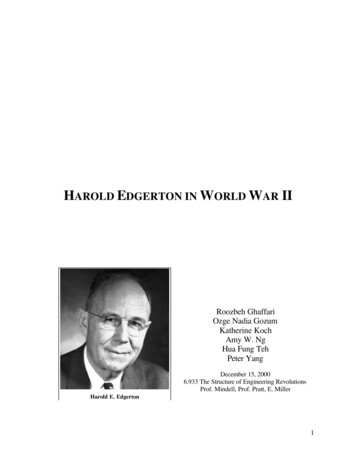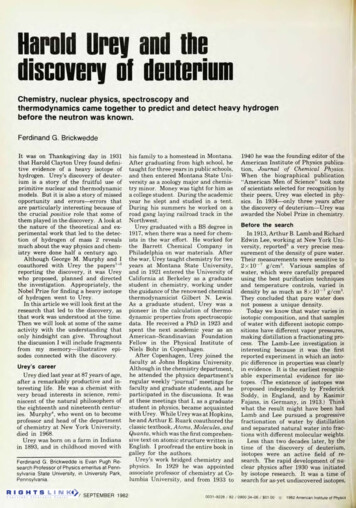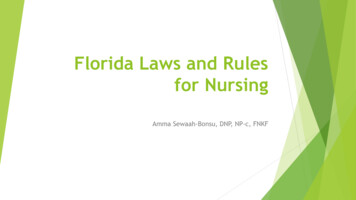
Transcription
FloridaResearch OutlineTable of ContentsRecords Of The Family History LibraryArchives And LibrariesFamily History Library CatalogBible RecordsBiographyCemeteriesCensusChurch RecordsCourt RecordsDirectoriesEmigration And ImmigrationGazetteersGenealogyHistoryLand And PropertyMapsMilitary RecordsNaturalization And CitizenshipNewspapersPeriodicalsProbate RecordsTaxationVital RecordsFor Further ReadingComments And SuggestionsThis outline describes major sources of information about families from Florida. As youread this outline, study the United States Research Outline (30972), which will help youunderstand terminology and the contents and uses of genealogical records.RECORDS OF THE FAMILY HISTORY LIBRARYThe Family History Library has some of the records described in this outline. The majorholdings are Spanish, federal, and state censuses. The library also has land, military,probate, and vital records.Some of the sources described in this outline list the Family History Library's book,microfilm, and microfiche numbers. These are preceded by FHL, the abbreviation forFamily History Library. These numbers may be used to locate materials in the library andto order microfilm and microfiche at Family History Centers.
ARCHIVES AND LIBRARIESThe following archives, libraries, and societies have collections or services helpful forgenealogical research. Florida Department of StateBureau of Archives and Record ManagementMail Station 9AR.A. Gray BuildingTallahassee, FL 32399-0250Telephone: 904-487-2073Fax: 904-488-4894As of January 1984 the genealogy collection of the Florida State Library was transferredto the Florida State Archives. However, the Florida State Library, which is also in theR.A. Gray Building, still has references of interest to the genealogist, especially in the“Florida Collection.” National Archives—Southeast Region (Atlanta)1557 St. Joseph AvenueEast Point, GA 30344Telephone: 404-763-7477Fax: 404-763-7815 Florida State Genealogical SocietyP.O. Box 10249Tallahassee, FL 32302Telephone: 1-813-872-0280 Florida Historical Library435 Brevard Ave.Cocoa, FL 32922Telephone: 1-407-690-1971 Florida UniversityDepartment of Special CollectionsSmathers Library Room 100P.O. Box 117007Gainesville, FL 32611
Telephone: 352-392-0319Fax: 352-392-4788 University of West FloridaJohn Chandler Pace Library11000 University ParkwayPensacola, FL 32514-5750Telephone: 850-474-2492Fax: 850-474-3338 University of MiamiOtto G. Richter LibraryP.O. Box 248214Coral Gables, FL 33124Telephone: 305-284-3551Fax: 305-665-7352 Orange County Library System101 East CentralOrlando, FL 32801Telephone: 407-425-4694Fax: 407-648-0523Two helpful guides for several important Florida archives and libraries are:Catalog of the Florida State Archives. Tallahassee, Fla.: Department of State, 1975.(FHL book 975.9 A5fs no. 1.)Guide to Depositories of Manuscript Collections in the United States: Florida.Jacksonville, Fla.: Florida Historical Records Survey Project, 1940. (FHL book 975.9 A1no. 130.)To learn more about the history and record-keeping systems of Florida counties, use the12 inventories of the county archives published by the Historical Records Survey around1940. Copies are at the Family History Library.Computer Networks and Bulletin BoardsComputers with modems can be useful tools for obtaining information from selectedarchives and libraries. In a way, computer networks themselves serve as a library. TheInternet, certain computer bulletin boards, and commercial on-line services help familyhistory researchers:
Locate other researchersPost queriesSend and receive e-mailSearch large databasesSearch computer librariesJoin in computer chat and lecture sessionsYou can find computerized research tips and information about ancestors from Florida ina variety of sources at local, state, national, and international levels. The list of sources isgrowing rapidly. Most of the information is available at no cost.Addresses on the Internet change frequently. As of April 1997, the following sites areimportant gateways linking you to many more network and bulletin board sites: USGenWebhttp://www.usgenweb.com/A cooperative effort by many volunteers to list genealogical databases, libraries, bulletinboards, and other resources available on the Internet for each county, state, and country. Roots-Lhttp://www.rootsweb.ancestry.com/roots-l/A useful list of sites and resources. Includes a large, regularly updated researchcoordination list.For further details about using computer networks, bulletin boards, and news groups forfamily history research, see the United States Research Outline (30972), 2nd ed.,“Archives and Libraries” section.FamilySearch The Family History Library and some Family History Centers have computers withFamilySearch . FamilySearch is a collection of computer files containing severalmillion names. FamilySearch is a good place to begin your research. Some of the recordscome from compiled sources; some have been automated from original sources.
FAMILY HISTORY LIBRARY CATALOGThe library's records are listed in the Family History Library Catalog found at the libraryand at each Family History Center. To find a record, look in the Locality Search of thecatalog for: The place where your ancestor lived, such as:UNITED STATES - CENSUS RECORDSFLORIDA - LAND RECORDSFLORIDA, DUVAL - VITAL RECORDSFLORIDA, DUVAL, JACKSONVILLE - CEMETERIES The record type you want to search, such as:UNITED STATES - CENSUS RECORDSFLORIDA - LAND RECORDSFLORIDA, DUVAL - VITAL RECORDSFLORIDA, DUVAL, JACKSONVILLE - CEMETERIESThe section headings in this outline match the names of record types used in the catalog.BIBLE RECORDSThe Daughters of the American Revolution (DAR) collection contains some Biblerecords. This collection is described in the “Genealogy” section of this outline. Someadditional Bible transcripts are found at the DAR Library in Washington, D.C. and at theFamily History Library on films 850399-404 and 907982.The DAR Bible records are partially indexed by E. Kay Kirkham, An Index to SomeFamily Records of the Southern States (Logan, Utah: Everton Publishers, 1979; FHLbook 973 D22kk v. 1; fiche 6089183).BIOGRAPHYStatewide, regional, and county histories often have biographical sections that can bevery helpful. A representative biographical encyclopedia is Harry Gardner Cutler, Historyof Florida, Past and Present . . . , 3 vols (Chicago and New York: Lewis Publishing Co.,
1923; FHL book 975.9 H2c; vol. 1 on film 1321188, vol. 3 on film 1697443 item 10).Volumes 2 and 3 have biographical information.Helpful indexes available at the Family History Library and the St. Augustine HistoricalSociety are the Biographical Card Index (on 18 FHL films beginning with 967146) andthe alphabetical Biographical and Genealogical File (on 9 FHL films beginning with967703).CEMETERIESThe Daughters of the American Revolution (DAR) collection contains tombstoneinscriptions from Florida cemeteries. This collection is described in the “Genealogy”section of this outline. Another important collection of cemetery inscriptions is E. H.Hayes, Cemetery Records of Florida, 9 vols. (Salt Lake City: Genealogical Society,1946-66; FHL book 975.9 V3c; films 874012-3).The collection Cemetery Records in Florida and Georgia is on FHL films 228823-28.This index is arranged by county and gives information about births, deaths, parents, andspouses. A directory of cemetery records that lists the names and locations of cemeteriesin Florida is on FHL film 1206385.The Family History Library also has 35 microfilms of records from several Tampafuneral homes. These are listed in the catalog under FLORIDA, HILLSBOROUGH,TAMPA - VITAL RECORDS.CENSUSFederalMany federal census records are found at the Family History Library, the NationalArchives, and other federal and state archives. The United States Research Outlineprovides more detailed information about these records.The Family History Library has microfilms of the federal censuses of Florida from 1830,1840, 1850, 1860, 1870, 1880, 1900, 1910, and 1920. The 1890 census and veteransschedules were destroyed.Statewide indexes are available for the 1820, 1830, 1840, 1850, 1860, and 1870 censuses.Soundex (phonetic) indexes on microfilm exist for part of the 1880 and all of the 1900,1910 and 1920 censuses.
The Florida State Archives has the 1850, 1860, 1870, and 1880 mortality schedules. TheFamily History Library has the published indexes for each of these schedules.Colonial, Territorial, and StateColonial, territorial, and state censuses exist for 1783, 1786, 1790, 1793, 1814, 1825,1837, 1845, 1855, 1865, 1868, 1875, 1885, 1895, 1935, and 1945. (Censuses taken inlater years were destroyed.) Beginning with 1855, specific information is given for eachindividual. Only scattered fragments are available for the 1855 through 1895 censuses.The censuses listed above are at the Florida State Archives. The Family History Libraryhas returns for a few counties for various years on microfilm. The 1885 enumerations for35 counties are on FHL films 888962-74.CHURCH RECORDSBefore 1900 the largest religious groups in Florida were the Baptist, Methodist-Episcopal(now United Methodist) and Roman Catholic. The Family History Library has a feworiginal records of Florida churches and some materials that have been published by theDAR and others.For more information about churches in Florida, see:A Preliminary List of Religious Bodies in Florida. Jacksonville: Historical RecordsSurvey, 1939. (FHL book 975.9 K2ha; film 1036590 item 6; fiche 6019561.)Guide to the Supplementary Vital Statistics from Church Records in Florida. 3 vols.Jacksonville: Historical Records Survey, 1942. (FHL book 975.9 V2h; FHL film1425703 item 6.)Some denominations have collected their records into central repositories. You can writeto the following addresses to learn where their records are located:BaptistFlorida Baptist Historical SocietyStetson UniversityP.O. Box 8353Deland, FL 32720Telephone: 904-822-7175 Fax: 904-822-7199Internet: http://www.floridabaptisthistory.org
Southern Baptist Historical Library and Archives901 Commerce St., Suite 400Nashville, TN 37203-3630Telephone: 615-244-0344 Fax: 615-782-4821Internet: http://www.sbhla.org/The Family History Library has microfilms of some of the minutes and membership listsfrom the Southern Baptist Historical Commission.Many of the Baptist associations and their records are described in Inventory of theChurch Archives of Florida: Baptist Bodies (Jacksonville: Historical Records Survey,1939-1940; FHL books 975.9 K2h; film 1036585 item 4).MethodistFlorida United Methodist History CollectionE. T. Roux LibraryFlorida Southern CollegeLakeland, FL 33811Telephone: 941-680-4164Fax: 941-680-4126United Methodist Archives CenterDrew University LibraryP.O. Box 127Madison, NJ 07940Telephone: 201-408-3189Fax: 201-408-3909A history of churches and congregations is in George G. Smith, The History ofMethodism in Georgia and Florida: From 1785 to 1865 (Macon, Ga.: Jno. W. Burke andCo., 1877; FHL book 975 K2s; fiche 6048432).Roman CatholicArchdiocese of Miami9401 Biscayne Blvd.Miami Shores, FL 33138Telephone: 305-757-6241Fax: 305-754-1897The Family History Library has 14 microfilms of records for the years 1594 to 1924 fromthe main cathedral in St. Augustine. Other early records are described in Thomas T.McAvoy, Guide to the Microfilm Edition of the Records of the Diocese of Louisiana and
the Floridas, 1576-1803 (Notre Dame, Ind.: University of Notre Dame Archives, 1976;FHL book 976.3 A1 No. 15).COURT RECORDSFlorida courts that kept records of genealogical value were established as rcuit courts in each county have jurisdiction over minorcivil cases, probate, equity, guardianship, and felonies foreach county.County judges keep probate, marriage, administration, andguardianship records.Criminal courts have records of criminal cases notpunishable by capital punishment.Civil courts exist in counties with populations of more than100,000. In these counties, the civil court takes the place ofthe county court.The Family History Library has a few Florida court records. From Duval County, forexample, the library has circuit court indexes to judgments and satisfactions (1901-23).The Florida State Archives has microfilm copies of many of the county records and someof the records from higher appeals courts. You may also obtain copies of the records bycontacting the clerk's office in the appropriate county.For more information about federal court records see Inventory of Federal Archives in theStates: Series II. The Federal Courts No. 9 Florida (Jacksonville: Historical RecordsSurvey, 1940; FHL book 975.9 A1 no. 133; film 924006 item 7).DIRECTORIESDirectories of heads of households have been published for major cities in Florida. Forexample, the Family History Library has directories for Miami for the years 1941, 1942,1953, 1966 and 1970 (FHL book 975.938 E4p; film 1421916 item 3 is for the year 1942).The Family History Library has a set of microfilms with Miami City directories 19041935 (beginning on FHL film 1759897).The library also has directories for Jacksonville covering the years 1931, 1941, 1946,1950, 1953 and 1971 (FHL book 975.912/J1 E4p).
EMIGRATION AND IMMIGRATIONImmigrantsPre-statehood settlers of Florida generally arrived after 1817 from the older southernstates, especially Georgia and the Carolinas. The East Florida non-Indian populationhovered between 3,000 in 1763 and 5,000 in 1817 as the colony passed from the Spanishto the British and then back to Spanish possession.By 1768 the British had imported over 1,200 Greeks, Italians, and Minorcans to the NewSmyrna settlement. Many of them died, and by 1778 the remaining inhabitants werescattered through St. Augustine, where Minorcans are still an identifiable part of thepopulation.Thousands of loyalist refugees arrived from the rebellious American colonies beginningin 1775, but most were deported after 1783 to the Bahamas, Jamaica, and other islands ofthe British West Indies. A few Americans from the southern states and British plantersreturning from the Bahamas entered Florida between 1790 and 1804. In 1804, theSpanish officially closed East Florida to American immigration, but settlers continued tocross the Georgia-Florida border, especially after 1812.Most persons migrating from the United States settled in the northern section of the state.After the Seminole Wars of 1817-18 and 1835-42 had dispossessed the Indians of theirlands, white settlement gradually moved southward. Today there are over 1,000 SeminoleIndians living in Florida near Lake Okeechobee.The state remained sparsely settled until after the Civil War. Then land speculation, theconstruction of railroads, and the building of resorts attracted new residents from thenorthern states. There were white settlers in all parts of Florida by 1900, when the totalpopulation reached 500,000. The population doubled to one million by 1920, when asecond Florida land boom was underway. As the thinly-settled areas of southern Floridafilled in, 13 new counties were created between 1921 and 1925.Blacks have been in Florida since early colonial times. There were as many blacks aswhites in Florida between 1830 and 1900.Refugees from revolutionary troubles in Cuba came to Florida beginning in 1868.Immigrants from northern Spain, Italy, Greece, and other areas of southeastern Europearrived in the late nineteenth and early twentieth centuries.Records
Ports of entry to Florida have included St. Augustine, Key West, and Tampa. TheNational Archives and the Family History Library have: Passenger lists for St. Augustine, 1821 to 1824, 1827, and 1870, and Key West,1837 to 1852 and 1857 to 1868. These are included in Copies of Lists ofPassengers Arriving at Miscellaneous Ports on the Atlantic and Gulf Coasts,listed in the catalog under UNITED STATES - EMIGRATION ANDIMMIGRATION (beginning on FHL film 830231).These are indexed by Supplemental Index to Passenger Lists of Vessels Arriving atAtlantic and Gulf Coast Ports, listed in the catalog under UNITED STATES EMIGRATION AND IMMIGRATION - INDEXES (beginning on FHL film 418161). Passenger lists for Key West, 1898 to 1920, listed in the catalog under FLORIDA,MONROE, KEY WEST - EMIGRATION AND IMMIGRATION (beginning onFHL film 1375956). Index to Passenger Lists of Vessels Arriving at Miscellaneous Ports in Alabama,Florida, Georgia, and Southern Carolina, 1890 to 1924, listed in the catalogunder UNITED STATES - EMIGRATION AND IMMIGRATION - INDEXES(FHL films 1324938-63).You should also check passenger lists for other ports, especially New Orleans. TheNational Archives also has passenger lists for about ten minor ports in Florida, 19001945. More detailed information on immigration sources is in the United States ResearchOutline.Records of the Seminole Indians are listed in the subject catalog under the name of thetribe. Records of colonial Greek and Italian groups are listed in the catalog underFLORIDA - MINORITIES.GAZETTEERSA number of gazetteers of Florida have been published. Three of the most helpful are:Morris, Allen Covington. Florida Place Names. Coral Gables, Fla.: University of MiamiPress, 1974. (FHL book 975.9 E2m.)Florida Gazetteer and Business Directory. Jacksonville, Fla.: R.L. Polk & Co., 1908.(FHL book 975.9 E5po; fiche 6046880.)GENEALOGY
Most archives, historical societies, and genealogical societies have special collections andindexes of genealogical value. These must usually be searched in person.A notable manuscript collection of compiled genealogies is the Daughters of theAmerican Revolution (DAR) Collection. This collection consists of transcripts ofobituaries, wills, and Bible, cemetery, church, marriage, and death records. One set ofvolumes was microfilmed in 1971 at the DAR Library in Washington, D.C., and is on 20microfilms at the Family History Library. A second set of volumes was filmed at theFlorida Division of Archives, History, and Records Management in 1956 (FHL films006954-55). The volumes are generally arranged by county, and many have individualindexes. The DAR films are listed in the Family History Library Catalog under variouscounties and subject headings.HISTORYThe following important events in the history of Florida affected political boundaries,record keeping, and family The Spanish founded St. Augustine, the first permanentwhite settlement in what is now the United States. Pensacolawas founded by the Spanish in 1698, but there was littlesignificant European settlement in Florida until the lateeighteenth century.At the close of the Seven Years' War (French and IndianWar), Britain gained control of Florida. Settlers fromEurope and the American colonies to the north began tomove into the area. The provinces of East Florida and WestFlorida were formed.Most of the British settlers left when Spain regained theFloridas.The United States annexed portions of West Florida toLouisiana and to the Mississippi Territory.Spain ceded the remainder of West Florida and all of EastFlorida to the United States. Official United Statesoccupation took place in 1821, and Florida was organized asa territory in 1822.At the close of the Seminole Wars, most of the Indians wereremoved west to present-day Oklahoma, but a few hundredescaped into the swamps.Florida became a state.Florida seceded from the Union. It was readmitted in 1868.The post-Civil War boom brought many settlers to Florida,
1921-1925as developers from the North built railroads and resorts.The last 13 of the state's 67 counties were organized as theFlorida land boom attracted new settlers from the north.An especially helpful source for studying the history of Florida is Junius E. Dovell,Florida: Historic- Dramatic-Contemporary, 4 vols. (New York: Lewis HistoricalPublishing Co., 1952; FHL book 975.9 H2do).LAND AND PROPERTYColonial Land GrantsFlorida was a disputed possession of England, France, and Spain in turn until it finallybecame a possession of the United States in 1821. A board of land commissioners forWest Florida was established in 1822 and for East Florida in 1823 to process claims tolands previously granted by other nations. These documents, as well as land ancestriesand homestead records, are at the Florida State Archives. The Family History Library hasmicrofilm copies of some of the archive's files, including: Spanish Land Grant Archives, 1764-1844. (FHL films 1020288-95.) These arewritten in Spanish and English. Some are indexed. Many of these are transcribedin Spanish Land Grants in Florida: Briefed Translations from the Archives of theBoard of Commissioners, 5 vols. (Tallahassee: Historical Records Survey, 19401941; FHL book 975.9 R2hs; films 897334-35 or 1020203-4).Land Claims, 1824-1828, confirmed and unconfirmed. (FHL films 1020205-17and 1020284-87.)A helpful publication is Phillip W. McMullin, Grassroots of America (Salt Lake City:Gendex Corp., 1972; FHL book 973 R2ag index; fiche 6051323). This indexes claims toU.S. land which are transcribed in the American State Papers (on microfilm at the FamilyHistory Library).Federal Land GrantsFlorida eventually became a public domain state. The first general land office wasestablished at Tallahassee in 1825. Original patents and copies of tract books andtownship plats are located at the Bureau of Land Management (Eastern States Office,7450 Boston Blvd., Springfield, VA 22153; Telephone: 703-440-1600, Fax: 703-4401609). The National Archives has donation and land entry case files and an index to pre1908 patentees who did not file private claims.County Land Records
After land was transferred to private ownership, subsequent transactions were recordedby the clerk of the circuit court, who was the county recorder. In some counties landrecords were recorded by a county court or a county judge.The Family History Library has land records from many Florida counties. These includedeeds, homesteads, mortgages, plat books, order books, and tract books. For example, theFamily History Library has 51 microfilms of Orange County deeds (1843-90), and deedindexes (early-1937).MAPSThe University of Florida in Gainesville has the largest collection of Florida maps. TheFlorida State University also has a sizable map collection.The Family History Library has a small collection of maps dating from the colonial eraand other maps made by the General Land Office and by the U.S. Geological SurveyMILITARY RECORDSThe U.S. Military Records Research Outline (34118) provides more information onfederal military records and search strategies.Many military records are found at the Family History Library, the National Archives,and other federal and state archives. The United States Research Outline provides moreinformation about the federal records. For Florida the following sources are also veryhelpful:Indian Wars (1815-1858)An index to compiled military service records for Indian Wars and disturbances from1815 to 1858 is at the Family History Library (FHL films 882753-94). The indexincludes soldiers who served in the Seminole and Florida Wars, 1817 to 1818 and 1835 to1842. The compiled military service records for the Florida War, 1835 to 1858, are alsoavailable (beginning on FHL film 1303446).The library also has an index to Indian Wars pension files, 1892 to 1926 (FHL films821610-21). The index includes those soldiers who served between 1817 and 1898. Theactual pension files have not been filmed and are only at the National Archives.Civil War (1861-1865)
Soldiers from Florida served in both the Union and the Confederate armies. The FamilyHistory Library and the National Archives have the following: UnionCompiled service recordsFHL films 1299987-97Index to service recordsFHL film 821727Index to pension recordsFHL films 540757-541300(Pension records are only atthe National Archives) ConfederateService recordsService recordsPension recordsIndex to pension recordsFHL films 880103-106FHL films 880001-9FHL films 006718-885FHL film 006717State militia records for the Confederate period are at the state arsenal in St. Augustine.For information, write to:Adjutant GeneralDepartment of Military AffairsAttn.: M.I.L.P.P.O. Box 1008St. Augustine, FL 32085-1008Telephone: 904-823-0315Fax: 904-823-0309Spanish-American War (1898)The compiled military service records of volunteer soldiers who served in the FloridaInfantry are at the National Archives and the Family History Library (FHL films1314126-38). Published rosters are found in Soldiers of Florida in the Seminole IndianCivil and Spanish-American Wars (Live Oak, Fla.: Democrat Book and Job Print, 1909;FHL book 975.9 M2s; film 988193).World War I (1917-1918)World War I draft registration cards for men ages 18 to 45 may list address, birth date,birthplace, race, nationality, citizenship, and next of kin. Not all registrants served in thewar. For registration cards for Florida see:
United States. Selective Service System. Florida, World War I Selective Service SystemDraft Registration Cards, 1917-1918. National Archives Microfilm Publications, M1509.Washington, D.C.: National Archives, 1987-1988. (On FHL films beginning with film1556849.)To find an individual's draft card, it helps to know his name and residence at the time ofregistration. The cards are arranged alphabetically by county, within the county by draftboard, and then alphabetically by surname within each draft board.Most counties had only one board; large cities had several. A map showing theboundaries of individual draft boards is available for most large cities. Finding anancestor's street address in a city directory will help you in using the draft board map.There is an alphabetical list of cities that are on the map. For a copy of this map see:United States. Selective Service System. List of World War One Draft Board Maps.Washington, D.C.: National Archives. (FHL film 1498803.)NATURALIZATION AND CITIZENSHIPNaturalization records have been filed in the county, circuit, and U.S. district courts. TheFamily History Library has copies of the records from very few counties.The National Archives—Southeast Region (Atlanta) has naturalization records of theU.S. district court for the Southern District of Florida (Key West) for the years 1875 to1948 and records for the Southern District of Florida (Miami) for 1907 to 1948.For naturalization records after September 1906, contact the National Archives—Southeast Region (Atlanta) or the local office of the Immigration and NaturalizationService.NEWSPAPERSThe Florida State Library and other major libraries have Florida newspaper collections.The Family History Library has no Florida newspapers but has collected a few publishedabstracts and indexes of obituaries.PERIODICALS
The major genealogical periodicals and magazines helpful for Florida research are:Ancestry. 1966–. Published by The Palm Beach County Genealogical Society, P.O. Box1746, West Palm Beach, FL 33402; Telephone: 407-832-3279. (FHL book 975.932 B2a;vols. 1-5 on film 874055 items 1-3.)The Florida Armchair Researcher. 1984–. Published by Armchair Publications, 810McDonough Rd., Hampton, GA 30228. (FHL book 975.9 D25f.)Journal. 1961–. Published by the Florida Genealogical Society, P.O. Box 18624, Tampa,FL 33679-8624. (FHL book 975.9 D25fgj.)The Florida Genealogist. 1977–. Published by the Florida State Genealogical Society,P.O. Box 10249, Tallahassee, FL 32302-2249; Telephone: 813-872-0280. (FHL book975.9 D25fg.)Jacksonville Genealogical Society Quarterly. 1973–. Published by the JacksonvilleGenealogical Society, P.O. Box 60756, Jacksonville, FL 32236-0756. (FHL book975.912/J1 D25j.)South Florida Pioneers. 1974–. Published by Richard M. Livingston, P.O. Box 3749,North Fort Myers, FL 33918. (FHL book 975.9 D25s; FHL films 1888609 items 2-20 forissues 1-28; film 1888610 items 1-12 for issues 29-52.)PROBATE RECORDSFlorida probate records have been kept by county judges and county clerks in eachcourthouse. Since 1968 they have been under the jurisdiction of the clerk of the circuitcourt in each county. The files may include wills, bonds, letters, petitions, order books,inventories, and settlements. You may obtain copies of the records from the clerk of thecircuit court.The Family History Library has copies of some probate records for Florida, such as the75 microfilms from Hillsborough County that include: Judges' administrations, 1847 to 1928Local and foreign wills, 1847 to 1930Probate packets, 1834 to 1944Guardianships, 1886 to 1929Register of estates, 1893 to 1926Minutes, 1882 to 1928General index to estates, 1834 to 1944
TAXATIONTax lists can be an important supplement to early census and land records. The FamilyHistory Library has 66 microfilms of tax rolls for 43 counties from as early as 1839 andas late as 1891 for some counties (FHL films 06888-953). Copies of these microfilms canalso be borrowed from the Florida State Archives.VITAL RECORDSCity and County Records of Births and DeathsThe offices of some county and city health departments have records from 1890 to 1916.The records of Jacksonville, Key West, Ocala, Orlando, Pensacola, St. Augustine, andTampa have been collected by the state. These are on film and open to the public at theFlorida State Archives. Individual counties have records of delayed birth registrations.The Family History Library has copies of original birth and death records for somecounties as well as an extensive collection of delayed birth records dating to the 1960s.For example, there are 22 microfilms of delayed birth records for Leon County, 1874 to1948, and 2 films of Pensacola birth and death records, 1891 to 1910.State Records of Births and DeathsStatewide registration of births and deaths began in 1899 and was generally compliedwith by 1920. Some earlier city and county records have been deposited with the stateoffice. They include incomplete records of births from 1
Two helpful guides for several important Florida archives and libraries are: Catalog of the Florida State Archives. Tallahassee, Fla.: Department of State, 1975. (FHL book 975.9 A5fs no. 1.) Guide to Depositories of Manuscript Collections in the United States: Florida. Jacksonville, Fla.: Florida Historical Records Survey Project, 1940.










